DEA 1500 | CITY
1/24
There's no tags or description
Looks like no tags are added yet.
Name | Mastery | Learn | Test | Matching | Spaced |
|---|
No study sessions yet.
25 Terms

cognitive appraisal
when people react to a space or location based on what it means to them / what it symbolizes

environmental determinism
when a space impacts the behavioral or physical development of someone despite what it means to them/symbolizes

Give an example of a physical element that likely illustrates determinism from the daycare setting shown above
colorful classroom developmentally stimulating for young children regardless of what the classroom means to them

How do your personal experiences from 3-4 yrs impact my cognitive appraisal of this daycare setting? (One specific element)
looking forward to school everyday, enjoying the friends, teachers, no problems.
associate with problem-free, happy times
the bright, colorful walls remind me of my preschool room, which always felt cheerful and welcoming. t
his preschool room provides me with positive and calming memories, along with overall nostalgia.

Do you think one or more aspect of your social identity are important or not to how you answer question c? Generate hypothetical data to support your answer and explain it
only child, small family
classroom was my only source of socialization with pppl other than parents

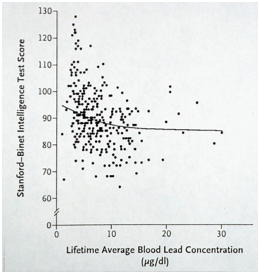
A: Describe three different things this graph suggests or implies about the relations between lead exposure and IQ.
As lead increases, IQ scores generally decrease. Suggests that higher lead exposure is linked to lower intelligence scores
Most have lead concentrations under 10 ug/dl meaning high exposure is rarer but still measurable
wide variation of IQ at low lead exposure, implying that lead isn’t the only factor influencing intelligence.
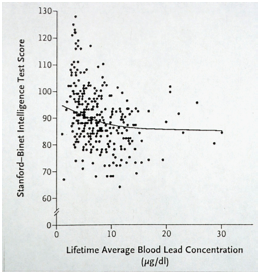
A scientist argues that the US is over regulating lead exposure by setting the standard of safe levels to 10 µg/dl of blood. Based upon the data in this graph, what is the principal reason for the scientist’s position?
The trend line in the graph flattens after 10 ug/dl, suggesting that any lead increase beyond this point only slightly decreases IQ. She might argue that restricting lead exposure to under 10 ug/dl offers minimal benefit to intelligence outcomes.
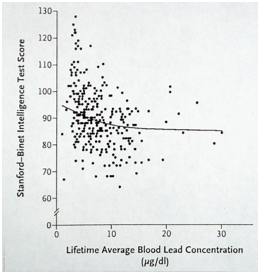
What is the major counterargument to the scientist’s position in part b?
Lead is harmful at any amount
Theres no safe level of lead because even low levels are linked to brain and behavior problems
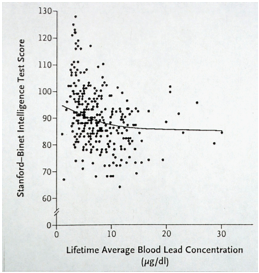
The scientist also argues that the scientific evidence for lead causing these IQ deficits is weak. Provide three arguments the scientist would make to back up her claim.
Too much variation in the data
The dots are scattered all over. Children with the same lead levels have very different IQ scores making it hard to prove a correlation between lead exposure and IQ
Other factors weren’t controlled (confounding variables)
Things like income, education, parenting, or nutrition could affect IQ too. The scientists may say the study didn’t fully separate those influences from lead.
Doesn’t prove cause and effect
Graph only shows slight correlation, not proof that the two directly relate
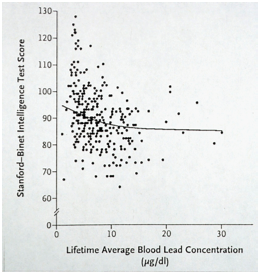
Design an ideal experiment, with human beings, to enhance the scientific quality of the evidence in order to push back against the scientist. Explain how your experimental design would provide findings that counter each of the scientist's three arguments re: weakness in the evidence the scientist is using to make her case. You can ignore ethical problems in your study proposal.
This study is really proving that more people have lead concentrations under ten, not that lead concentration affects IQ.
I would make sure each lead level group (0, 10, 20, 30) has the same number of people. If one group has way more participants, its results will vary more. Keeping group sizes equal makes the data fairer and easier to
I would control external factors like income, education, and nutrition to rule those factors out as contributors to IQ. Every participant would be from the same income, have the same education level, and eat the same etc.
Comparing groups under the same conditions would also show a stronger cause-and-effect connection than the previous experiment

This photo shows part of the experimental setting of an experiment Calhoun conducted on animal behavior and crowding. What is the relation between this experiment, by Calhoun, and Malthus’ theory of carrying capacity? State the carrying capacity theory and explain whether the results support or contradict Malthus’ theory and explain why.
Carrying capacity = the maximum number of individuals an area can carry
Malthus’ theory = population crashes when demand exceeds carrying capacity
In Calhoun’s experiment, the rats started showing abnormal behaviors such as aggression as a result of crowding
The results support Malthus’ theory because they show that when a population grows too large, the environment can no longer sustain normal, healthy life

Describe one type of human data covered in class or readings that show similar behavioral responses to crowding as uncovered in the Calhoun experiment.
There was a study conducted where participants were asked to collaborate in a group on a task. When the space they were in was crowded, researches noted an increase in errors (typos, miscalculations, etc)
Supports Malthus’ theory because when the space became overcrowded (exceeded carrying capacity) it was no longer able to support the participants in the tasks they needed to complete.

Using what you know about crowding from human studies, describe two additional measures you would add to Calhoun’s experiment. For each measure: Explain what you would expect to find with the measure. Draw upon prior research/theory to substantiate your arguments.
Access to control
People feel more crowded when they have no control over their environment (elevator button)
Proposed Change: I would track whether rats can control certain features of their space like nesting spots or access to tunnels
Expected finding: Rats given some control over their space would show lower stress levels and less aggression than rats with no control
Connection to Theory: aligns with research showing that access to control reduces psychological stress and perceived crowding, even when density stays the same
Measuring Task Performance
With humans, crowding worsens task performance, especially for group or interactive tasks
Proposed change: introduce simple behavioral tasks (maze navigation or food retrieval) to see if rats in high-density environments perform worse than those in lower-density ones
Expected findings: rats in overcrowded conditions would make more mistake or take longer to complete the tasks
Connection to theory: supports prediction that when population exceeds capacity, performance and wellbeing decline.

Describe two auditory effects of chronic noise exposure that an elderly Cornell alumnus should be concerned about.
Hearing Loss
Exposure to chronic noise can damage the tiny hair cells in the inner ear leading to permanent hearing loss, making it harder to hear speech or higher frequency sounds
Sleep Disruption (dementia)
Chronic noise can interrupt deep sleep cycles, even if a person doesn’t fully wake up.
Frequent sleep disturbance is linked to memory decline and increased dementia risk over time.
For an elderly alumnus, protecting sleep from noise is important for both cognitive and overall health

Describe what kind of research evidence you would ideally like to have to verify that noise rather than aging is having on one of these auditory effects on the elderly Cornell alumnus. Explain the logic of your idea.
Hearing ability data from coworkers
If the data shows that majority of employees, no matter the age, are experiencing permanent hearing loss, that would suggest that the cornell alum is losing his hearing ability due to the noises at work and not simply older age.

Describe two different non-auditory impacts you would want to check for in the Cornell alum and explain what evidence from prior research on noise you are using to suggest these two different alternatives.
Stress and Cardiovascular Issue
Non-auditory effects of noise include stress and cardiovascular problems, even when hearing is normal
Students living near airport had higher blood pressure
Cognitive Impairment
I would check the alumnus’ memory, focus, and attention because chronic noise can wear down cognitive efficiency over time
Noise causes cognitive impairment, particularly in attention and memory, with studies showing higher error rates as noise levels increase,
Workers in factories worked better with the headphones than without

Given your descriptions in part c., do you think these issues are likely to be more or less salient for an elderly person relative to a typical, current Cornell undergraduate? Please explain why.
More salient for an elderly
They’ve had longer exposure to noise (decades vs. a few years)
Long-term exposure -> more buildup of stress, cardiovascular strain, and cognitive wear
Older bodies also recover slower from chronic stress effects
Younger workers haven’t been exposed long enough to major impacts yet

Explain how this situation exemplifies the principle of learned helplessness?
Learned helplessness = when someone gets used to a problem that feel they cannot control and stop trying to change it as a result.
They feel like nothing they do will help, so they just accept it even if it bothers them
Susie’s experience exemplifies learned helplessness because, after meeting with her professor twice to no avail, she gave up, and disassociated for the rest of her meetings with him despite him having a change in mood and actually being extremely helpful.
After many failed attempts, stopped looking to her professor for help and as a result missed the times that he was helpful

Describe another study from class that illustrates this principle. Explain in what way the findings support the concept of learned helplessness?
Hospitals
Patients and healthcare staff are constantly exposed to high noise levels (machines alarms, voices, equipment)
Over time, staff may say its always loud here, nothing you can do about it

A study was discussed in lecture where a newborn interacted with a mobile. This study illustrated the benefits of control and mastery. Describe the different conditions the newborn was exposed to and explain two findings from the study supporting the argument that control and mastery are central to human beings.
Control condition
Mobile moved only when the infant kicked
Baby quickly learned that their own actions caused the movement
They got a sense of control and mastery over the environment
No-control condition
Mobile moved randomly, unrelated to the infant’s kicking
Baby could not predict or influence when the mobile moved, removing sense of control
Finding 1:
Infants with control over the mobile showed more kicking, attention, and excitement
demonstrate motivation and enjoyment when their actions had an effect
Finding 2:
When control was removed, infants became less active and more frustrated
Showed that losing control leads to stress and disengagement

Did this study also illustrate learned helplessness? Explain your answer.
Yes bc the baby stopped kicking when it realized it had no control of the mobiles movement.
If researchers were to switch out the random mobile for the controllable one, the baby would most likely still not kick bc it has come to the conclusion that there is nothing it can do to control the movement of the mobile.
How does human evolution relate to the Darwinian medicine argument outlined above?
Our stress response system evolved to handle brief, physical dangers, like predators or food scarcity in addition to smaller social groups, and constant physical activity.
As a result our bodies are maladapted to chronic, psychological ones like traffic, deadlines, or social pressure
Present three research findings from readings or lecture to support the Darwinian medicine argument and explain for each finding, why/how the evidence supports the argument.
Japanese diet adaption
Japanese who moved to Western and adapt to local food experience less stress than those who try to keep their traditional diet
Supports Darwin because it shows flexibility and adaption to ones environment can reduce stress
Smoking as a coping mechanism
Smoking to manage stress creates long term health problems like lung disease and heart issues
Fits darwinian view that modern stressors trigger behaviors that might help us cope temporarily but harm us biologically
Mismatch between old survival instincts and modern life
Crowding and social withdrawal
Modern cities overcrowding and constant stimulation can overwhelm people leading to withdrawal isolation or burnout
Supports darwinian argument that humans evolved for smaller social groups, modern urban density causes chronic stress
Describe data from a study of crowding, pollution, global warming, or noise, that could be used to illustrate Dubos’ theory of the paradox of human adaptability. Explain in what way the data support Dubos theory.
Studies showed that people living near airports or highways often claim they’ve “gotten used to” the noise — but their stress hormone levels and blood pressure remain elevated, and their sleep quality remains poor.
data show that while people perceive they’ve adapted to chronic noise, their bodies remain physiologically stressed.
They’ve normalized an unhealthy environment, illustrating Dubos’ warning that human adaptability can mask ongoing harm to well-being.
Apply Dubos’ theory of the paradox to human adaptability to the central importance of control, mastery, or self-efficacy. Describe how human exercise of control, mastery, or self-efficacy could paradoxically lead to a negative outcome. Explain how/why your example might fit with Dubos’ theory.
Smoking as a coping mechanism
People use smoking to gain control over stress or emotions (mastery)
This behavior harms physical health
Shows paradox
Humans adapt by creating coping tools that help psychologically n the short term but damage health long term
Ability to adapt and feel in control can backfire when the adaptation itself is unhealthy